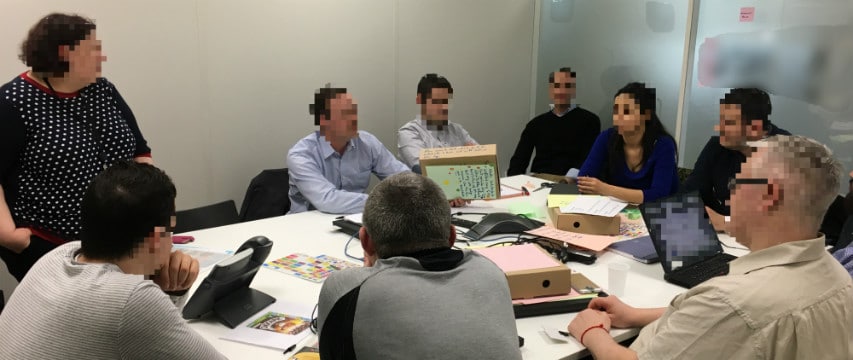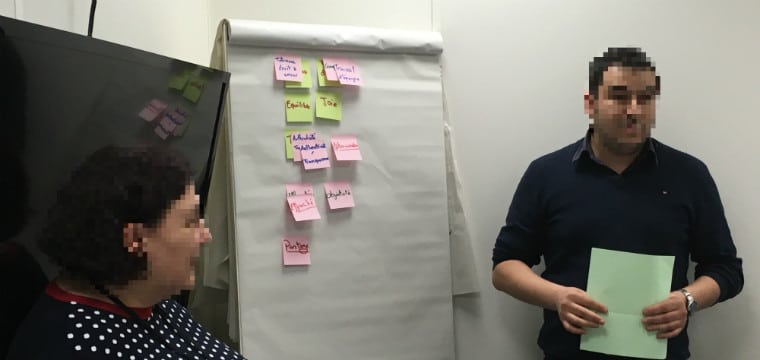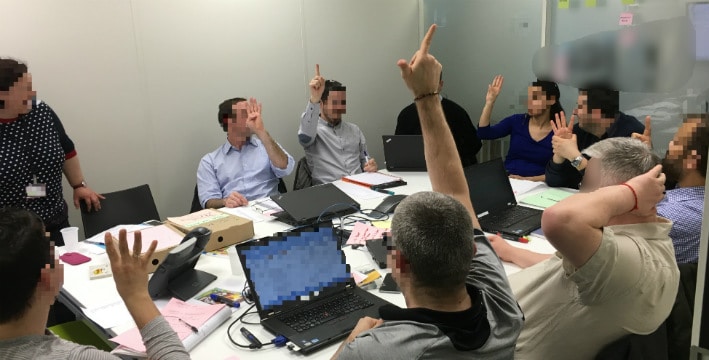
Le sprint 0 continue, et après notre premier atelier de cadrage de coaching, nous avons décidé avec l’équipe de coachs d’effectuer un atelier d’alignement où l’équipe aura l’occasion de se synchroniser tant au niveau de la direction à prendre que sur ses règles internes de fonctionnement. Après avoir préparé le contenu avec mes collègues, je laisse l’animation de l’atelier entre leurs mains pour rester un peu en recul en posture d’observacteur : j’observe et si besoin, j’interviens ! En voici le retour d’expérience ! 😉

Nous avons décidé de diviser cet atelier en 2 parties :
- Alignement sur la vision produit
L’objectif est que l’équipe s’accorde sur la vision du produit qu’elle compte réaliser.
Pour ce faire, nous avons prévu de réaliser un Atelier Product Box d’environ 1h.
- Alignement sur les valeurs d’équipe
L’objectif est que l’équipe définisse un cadre de collaboration.
Pour ce faire, nous avons prévu d’employer le même concept que pour la définition des attentes de l’atelier précédent en définissant les valeurs – décrites par des comportements mesurables – de l’équipe.
La Product Box

J’ai décrit le concept de l’atelier dans un article précédent. Je vous invite donc à aller y jeter un coup d’oeil si vous ne connaissez pas ! 🙂
Le cadre de l’atelier utilisé cette fois-ci fut :
- 2 itérations de construction (15 min)
- 2 revues (15 min)
La variante par rapport au cas décrit dans mon article sur la Product Box est que la 2nde itération fut effectuée par toute l’équipe sur une boite commune.
La première revue d’itération a donné lieu à des échanges intéressants en terme de perspective produit. En effet, une équipe a listé les fonctionnalités que le produit devait contenir alors que l’autre a tenté de représenter son apport à l’utilisateur. En débriefing, ce fut alors le moment d’aider les participants à sortir un petit la tête des fonctionnalités en tant que telles et de leur ouvrir l’esprit sur l’objectif d’un produit : répondre à un besoin client. D’ailleurs, cela aurait pu être l’occasion de rappeler les données du rapport chaos des années 2000 décrivant qu’un nombre important de fonctionnalités étaient peu voire jamais utilisées ! Tout simplement car elles ne répondaient pas à un besoin donc une utilisation des utilisateurs !
Note : en tant qu’observateur, ce que je garderais de cette partie est qu’il est important de bien éclaircir l’objectif de l’atelier pour bien focaliser les participants. En effet, l’énergie n’était pas toujours au rendez-vous ce qui a potentiellement donné un résultat plutôt mitigé par la suite.
Comment faire échouer le projet ?

Sentant une énergie en baisse, j’ai invité les participants à se munir d’une feuille A4 vierge et de répondre à la question suivante :
Quelles seraient les 10 merveilleuses techniques que vous utiliseriez pour faire échouer ce projet ?
Après quelques secondes d’hésitation de la part du groupe, chacun est parti dans l’élaboration de sa liste.
J’ai insisté pour que les réponses soient les plus concrètes possibles :
Je ne donnerais pas d’informations à X lors du Sprint Planning
Je ne testerais pas mes développements
Je ferais changer l’équipe toutes les semaines
…
L’objectif de cette phase était multiple :
- Permettre à chaque membre d’équipe de s’auto-dénoncer sur un comportement non constructif : de cette manière, on souhaite surtout réduire la probabilité que chaque élément cité soit effectivement mis en place.
- Donner un peu d’air à l’équipe : cette question inhabituelle a donné lieu à des rires et des échanges très intéressants autour des réponses de chacun.
Cette partie a permis à l’équipe de pouvoir partir en pause dans la bonne humeur et à ma grande surprise les échanges ont continué café en main ! 😉
Les valeurs d’équipe

Après la pause, nous sommes revenus pour parler de choses sérieuses : autour de quelles valeurs l’équipe allait-elle se souder ?
De la même manière que pour la définition des attentes du premier atelier, il était important de décrire les valeurs par des comportements permettant d’expliquer ce que l’on mettait derrière le terme.
Le processus utilisé fut le suivant :
- Chaque participant décrit 5 valeurs qui lui paraissent les plus importantes pour le fonctionnement de l’équipe. Il en inscrit une par Post-it. (environ 5′)
- On invite ensuite les participants à former des binômes et à sélectionner encore une fois les 5 valeurs qui leur paraissent les plus importantes pour le fonctionnement de l’équipe. Je précise que la description des comportements prend ici son importance pour pouvoir argumenter avec des éléments mesurables et compréhensibles. (environ 7′)
- Partage de chaque binôme sur les 5 valeurs sélectionnées accompagnées de la description des comportements associés. (environ 10′)
- Regroupement des valeurs similaires ou proches. (environ 2′)
- Sélection des 5 valeurs ou groupes de valeurs pour le fonctionnement de l’équipe. (environ 20′)
Il m’est toujours surprenant de voir les débats qui peuvent émerger autour du sujet des valeurs. Malgré l’intérêt intrinsèque que je leur porte, il a fallu à un certain moment aboutir à une décision de manière à pouvoir avancer dans l’atelier. Pour ce faire, j’ai proposé une version à 5 niveaux (5 doigts de la main) du protocole de Décision des Core Protocols. Maintenant, je pense que la version de base est largement suffisante.
En voilà une description :
- Effectuer une proposition concise, concrète et réalisable.
- Voter simultanément à main levée sur une échelle à 3 niveaux : Pour (pouce vers le haut), Contre (pouce vers le bas), Suiveur (main à plat).
- Pour chaque vote Contre, on utilise le protocole de Résolution qui consiste à déterminer les éléments qui permettraient aux Contre de basculer au moins en Suiveur.
ROTI (Return On Time Invested)

Pour terminer l’atelier, nous avons procéder à un simple ROTI.
Pour les personnes n’étant pas familières avec cet outil, le ROTI permet d’obtenir un feedback des participants sur le rapport « temps passé / valeur obtenue » sous forme d’un vote à main levée :
- 5 : Valeur obtenue << Temps passé : « Excellent. Je vais vraiment bénéficier de cette réunion ! »
- 4 : Valeur obtenue < Temps passé : « Bonne. Un réunion au-dessus de la moyenne ! »
- 3 : Valeur obtenue = Temps passé : « Moyenne. Je n’ai pas perdu mon temps, mais sans plus ! »
- 2 : Valeur obtenue > Temps passé : « Utile. Mais ça ne valait pas tout le temps que j’y ai passé ! »
- 1 : Valeur obtenue >> Temps passé : « Inutile. Je n’ai rien appris, j’ai vraiment perdu mon temps ! »
Le glas des votes tombés, nous en sommes sortis avec un résultat plutôt médiocre de 2.75 ! 😕
Les coachs ayant animé en grande partie l’atelier ont donc commencé à demander des explications aux participants ayant voté 1 et 2.
Pendant les échanges, je me suis discrètement rapproché du Paper Board et j’ai inscrit ces 3 mots : Transparence, Ouverture et Patience. En effet, cela correspondait aux attentes du coach vis à vis de l’équipe définies et acceptées lors de l’atelier précédent. Puis j’ai décidé d’intervenir pour échanger avec les participants et soutenir également mes collègues coachs devant ce résultat de premier abord peu encourageant.
Les remarques énoncées étaient assez similaires :
Je ne m’attendais pas à faire ce type d’exercice, je pensais que nous allions travailler sur le Product Backlog !
Il faut que l’on avance, on prend du retard et les deadlines, elles, ne bougent pas !
…
Note : A ma grande surprise, le manager faisait partie des personnes ayant mis un 4 au ROTI alors que l’on pourrait supposer le contraire dans un pattern « habituel ».
Ce à quoi j’ai cordialement répondu :
Je comprends votre volonté de vouloir avancer, je tiens cependant à vous rappeler le contrat de coaching que nous avons passé ensemble.
J’ai inscrit une nouvelle fois les 3 valeurs correspondant aux attentes de notre part vis à vis de vous et dans celles-ci vous retrouvez la patience, soit de vous donner le temps de faire les choses correctement. En effet, ces ateliers de synchronisation ont pour objectif de vous aider à partir dans la bonne direction dès le départ pour éviter de travailler pour rien : personnellement je n’aime pas courir à pleine vitesse tête baissée au risque de me prendre un mur ! 🙂
De plus, j’aimerais reprendre une des valeurs du Manifeste Agile : la collaboration plutôt que la négociation contractuelle. Nous, en tant que coachs, souhaitons ici tisser un lien de collaboration avec vous et non de client-fournisseur. Nous nous sommes d’ailleurs engagés en termes de moyens pour vous épauler au mieux. N’hésitez-pas à nous faire part de votre sentiment si le contenu des ateliers ne vous conviennent pas ou si vous n’en voyez pas l’intérêt, nous n’avons pas la prétention de tout savoir mieux que vous et bien au contraire, nous sommes là pour apprendre ensemble.
Dans la même idée, avez-vous besoin de nous pour commencer à travailler sur le Product Backlog ? Vous êtes bien plus qualifiés que nous en terme de contenu technique, notre plus value réside potentiellement dans la méthode sur laquelle je vous encourage à nous solliciter au fur et à mesure de votre avancement. D’ailleurs, nous nous étions engagés à être disponibles pour vous aider.
Ma volonté était donc de désamorcer ce mécanisme comportemental chronique d’attentisme des coachés vis à vis des coachs. En effet, l’autonomisation étant un des objectifs clés d’un coaching, je trouvais cela important de responsabiliser les membres de l’équipe dès le début pour qu’ils deviennent acteurs de leur accompagnement plutôt qu’ils le subissent.
L’atelier se clôtura alors dans des échanges constructifs quant à la suite des événements
Conclusion
Ce second atelier fut pour moi très enrichissant. Pas tant au niveau du contenu (je reste grand fan de l’orientation valeur et comportement) mais surtout au niveau des échanges qui en ont émergé. En effet, le ROTI final a été une grande source d’apprentissage et d’échanges avec l’équipe et l’occasion de concrétiser la véritable relation de coaching. Comme le dit le Manifeste Agile, les outils ne sont là qu’en support des individus et des interactions et pour le coup, des interactions il y en a eues ! 😉
L’alignement d’équipe est essentiel pour assurer un démarrage dans les meilleures conditions. Maintenant, vous rencontrerez souvent des personnes impatientes de mettre les mains dans le cambouis, à vouloir foncer tête baissée dans le travail. Il est important de les aider à voir au loin sur le rivage plutôt que des les laisser plonger dans leur épopée sous-marine pour enfin tisser une véritable relation de collaboration. 🙂






